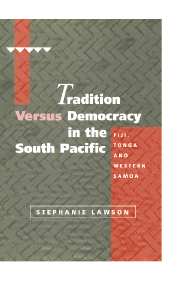Book contents
- Frontmatter
- Contents
- List of Maps
- List of Tables
- Preface
- Epigraph
- The South Pacific
- Introduction
- Chapter 1 Tradition and Democracy
- Chapter 2 Constitutional Development, Chiefly Power and the Politics of Tradition in Fiji
- Chapter 3 The Monarchy Versus Democracy in the Kingdom of Tonga
- Chapter 4 Preserving Tradition Through Democratization: The Introduction of Universal Suffrage in Western Samoa
- Chapter 5 Conclusion: Tradition Versus the West
- Notes
- Bibliography
- Index
Chapter 3 - The Monarchy Versus Democracy in the Kingdom of Tonga
Published online by Cambridge University Press: 22 September 2009
- Frontmatter
- Contents
- List of Maps
- List of Tables
- Preface
- Epigraph
- The South Pacific
- Introduction
- Chapter 1 Tradition and Democracy
- Chapter 2 Constitutional Development, Chiefly Power and the Politics of Tradition in Fiji
- Chapter 3 The Monarchy Versus Democracy in the Kingdom of Tonga
- Chapter 4 Preserving Tradition Through Democratization: The Introduction of Universal Suffrage in Western Samoa
- Chapter 5 Conclusion: Tradition Versus the West
- Notes
- Bibliography
- Index
Summary
Introduction
The islands which constitute the Kingdom of Tonga lie in three major groups (with numerous smaller islands around them) in the southwest Pacific region – southeast of Fiji and southwest of the Samoan islands – and yield a total land area of just under 700 square kilometres. Excluding the small outlying islands, the three main groups comprise the Tongatapu (southern) group; the Ha'apai (central) group; and the Vava'u (northern) group. Out of a total of around 160 islands, some 36 are inhabited and these sustain a population of about 95,000 people.
Until relatively recently the image of Tonga which struck most outside observers was one which exuded stability, contentment, and durability. The only remaining kingdom in the entire Pacific, Tonga had also been the only island country in the region to escape formal colonization during the period of European expansion in the nineteenth and twentieth centuries and was therefore spared the turbulence which has typically accompanied most moves to decolonization. It is widely accepted that Tonga's ability to remain independent had been achieved largely through the development of a unitary, centralized political system, presided over by an indigenous monarch, and which incorporated major elements of traditional sociopolitical organization. This system was entrenched through the promulgation in 1875 of a formal written constitution establishing the monarchy and a landed nobility, and codifying a set of principles and practices designed to sustain them as a ruling class.
- Type
- Chapter
- Information
- Tradition versus Democracy in the South PacificFiji, Tonga and Western Samoa, pp. 79 - 116Publisher: Cambridge University PressPrint publication year: 1996

